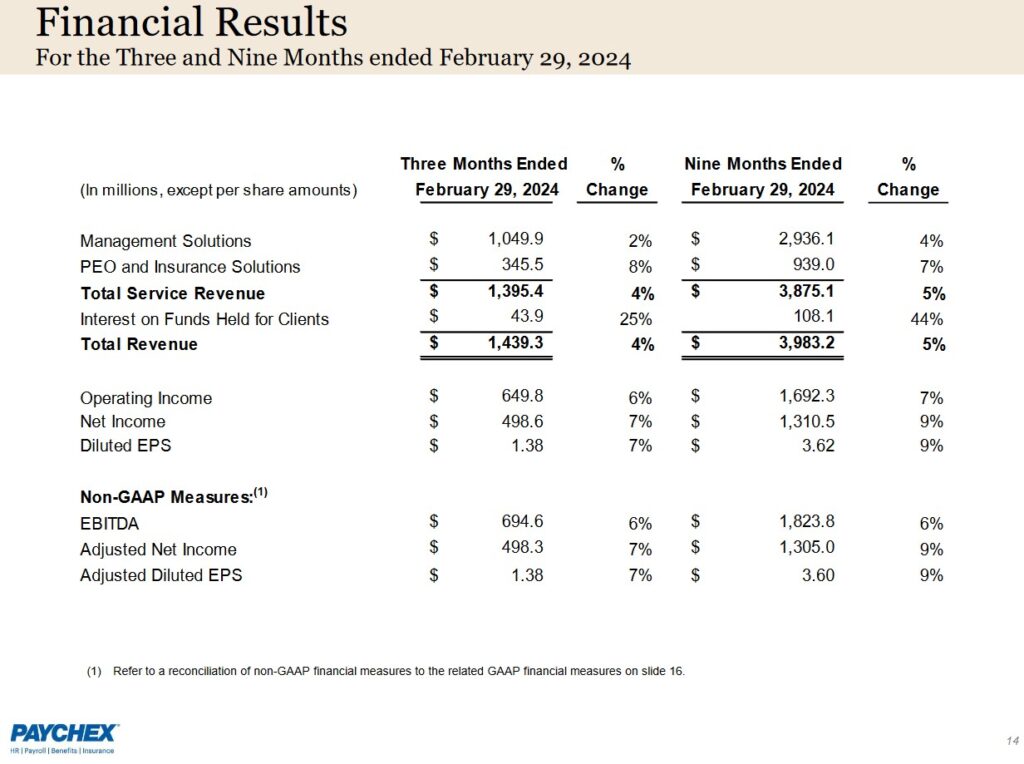Contents

I last reviewed Paychex (PAYX) in this December 21, 2023 post at which time Q2 and YTD2024 results and an update to the FY2024 outlook had just been released.
With the release of Q3 results and updated FY2024 outlook on April 2, I revisit this existing holding.
Business Overview
A Business Overview is provided in prior PAYX posts. It is preferable, however, that you read Part 1 of the FY2023 Form 10-K to gain a good understanding of the company.
Financial Review
Q3 and YTD2024 Results
PAYX's Q3 and YTD2024 results and FY2024 outlook are accessible here.
PAYX delivered solid Q3 and YTD results despite a lower revenue contribution for the company's Employee Retention Tax Credit (ERTC) service as compared with the prior year period. This was consistent with the company's previously communicated expectations that ERTC revenue would become a headwind in the second half of FY2024. Nevertheless, PAYX delivered 7% growth in diluted EPS and expanded operating margins due to the firm's longstanding tradition of expense discipline.
New client volumes remained solid and client and revenue retention was in line with expectations. The following factors, however, combined to create a larger than anticipated headwind:
- PAYX's decision to wind down the ERTC program based upon the recent legislative developments on Capitol Hill; and
- continued moderation of employment growth within PAYX's client bases.
On the Q3 earnings call, management stated:
The macroeconomic and labor market remains challenging for small and midsized businesses. A tight job market for qualified workers, reduced access to affordable growth capital and inflationary pressures continue to be headwinds for small businesses.
Our small business employment watch continues to show moderation in both job growth and wage inflation but, however, a relatively stable macro environment.
The softening in hiring we started to see in the second quarter continued in the third quarter. There is more choppiness in hiring across all customer segments and industries now.
Our clients tell us they still can't find qualified employees and are not willing to hire just anyone at higher wage rates, especially in areas with recent minimum wage increases and aggressive legislative changes.
Interest on funds held for clients increased 25% to ~$44 million, primarily due to higher average interest rates.
Despite a slower pace of growth, PAYX continues to generate strong Operating Cash Flow (OCF) and Free Cash Flow (FCF).
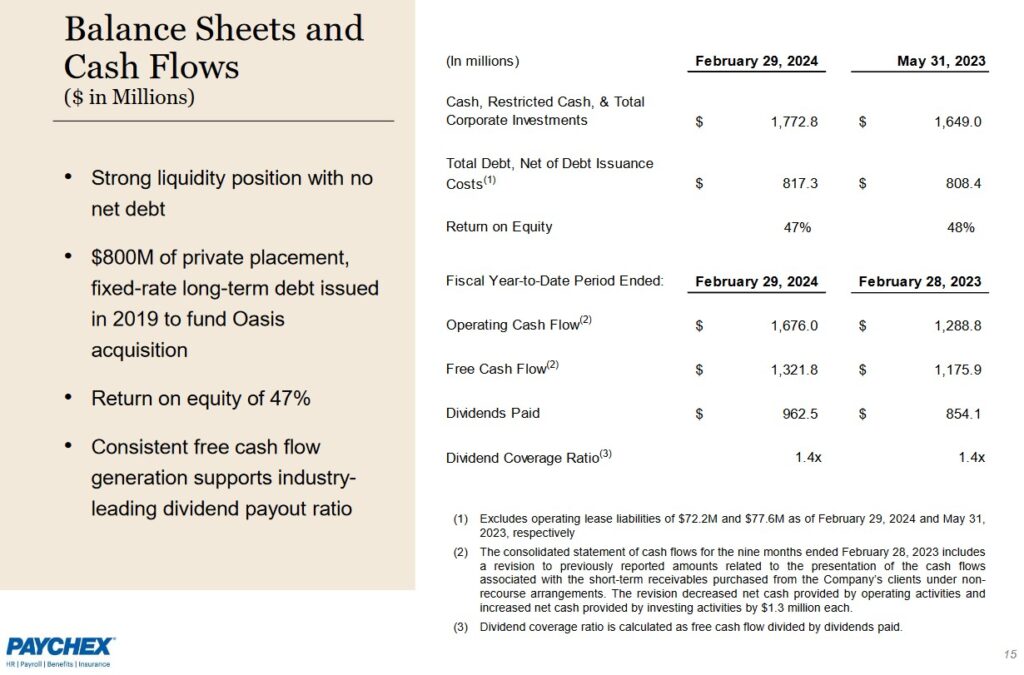
Source: PAYX - Q3 2024 Earnings Presentation - April 2, 2024
The following is what PAYX provided with the release of Q2 2024 results.
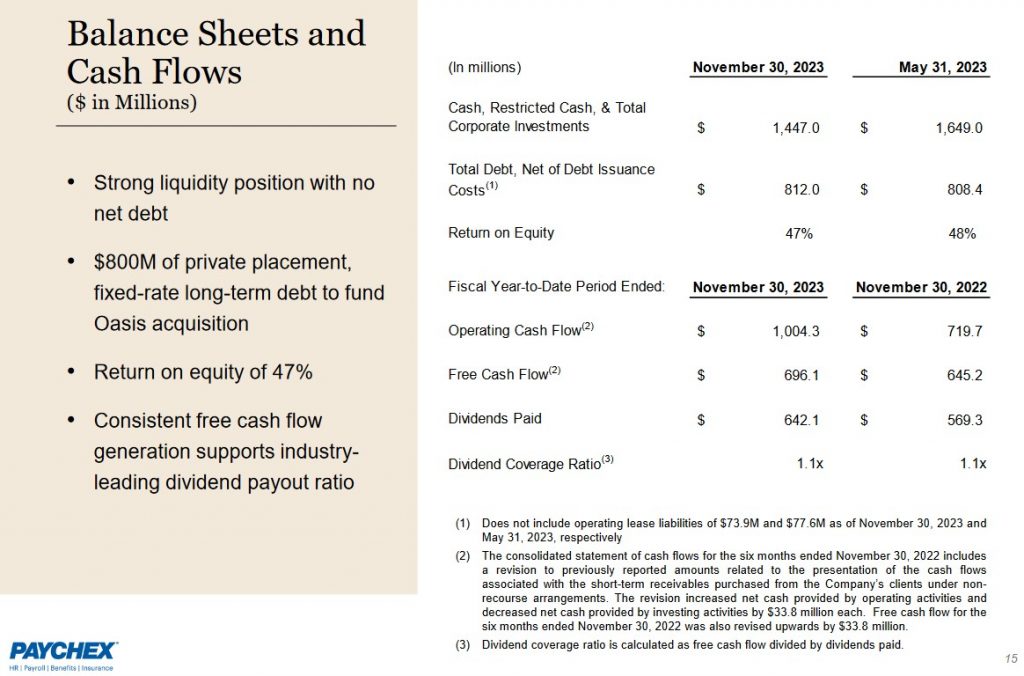
Source: PAYX - Q2 2024 Earnings Presentation - December 21, 2023
PAYX benefits from higher interest rates because is has client funds on deposit from which it can generate additional income. A rising interest rate environment benefits PAYX's short-term investments as seen from the average rate of returns reflected below. The rising rates, however, harm the longer-term component of the investment portfolio which explains the unrealized net loss on a mark-to-market basis. This, however, is an unrealized net loss as PAYX has not sold and crystalized these losses. If these investments are held to maturity, PAYX will incur no loss.
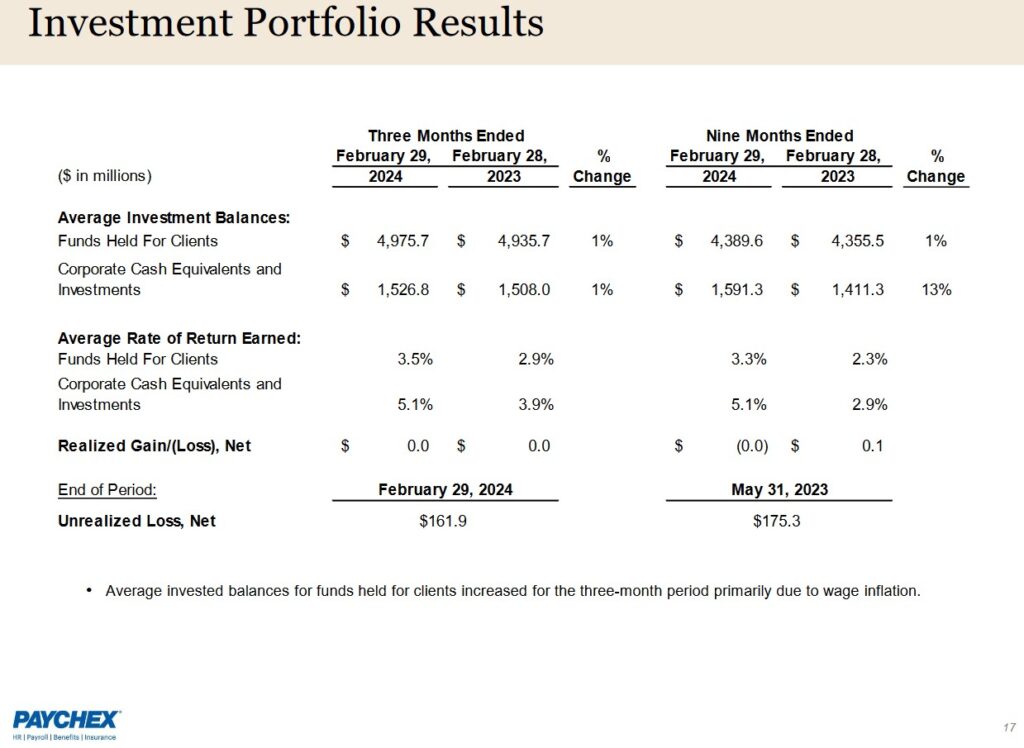
Source: PAYX - Q3 2024 Earnings Presentation - April 2, 2024
The following is what PAYX previously provided.
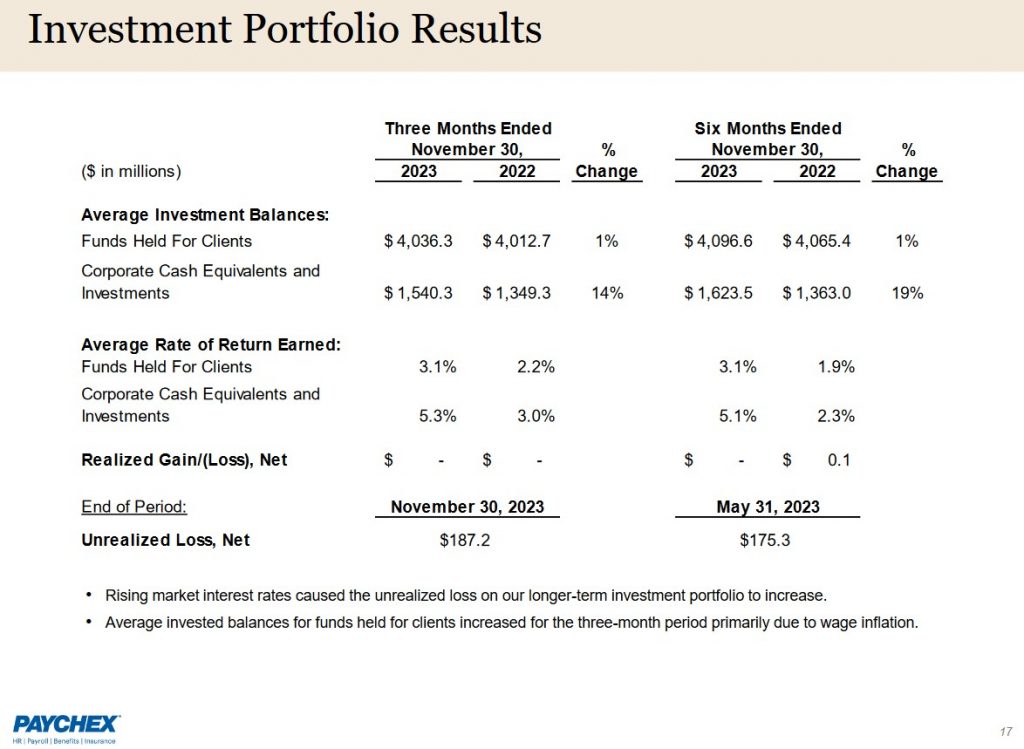
Source: PAYX - Q2 2024 Earnings Presentation - December 21, 2023
FY2024 Outlook
Management Solutions is now expected to grow 3.5% - 4%. PEO and Insurance is still expected to grow 7% - 9%, although management now expects it will be more toward the lower end of this range.
Management anticipates being at the high end of the 41% - 42% operating margin guidance range and anticipates total revenue growth to be ~5% in Q4.
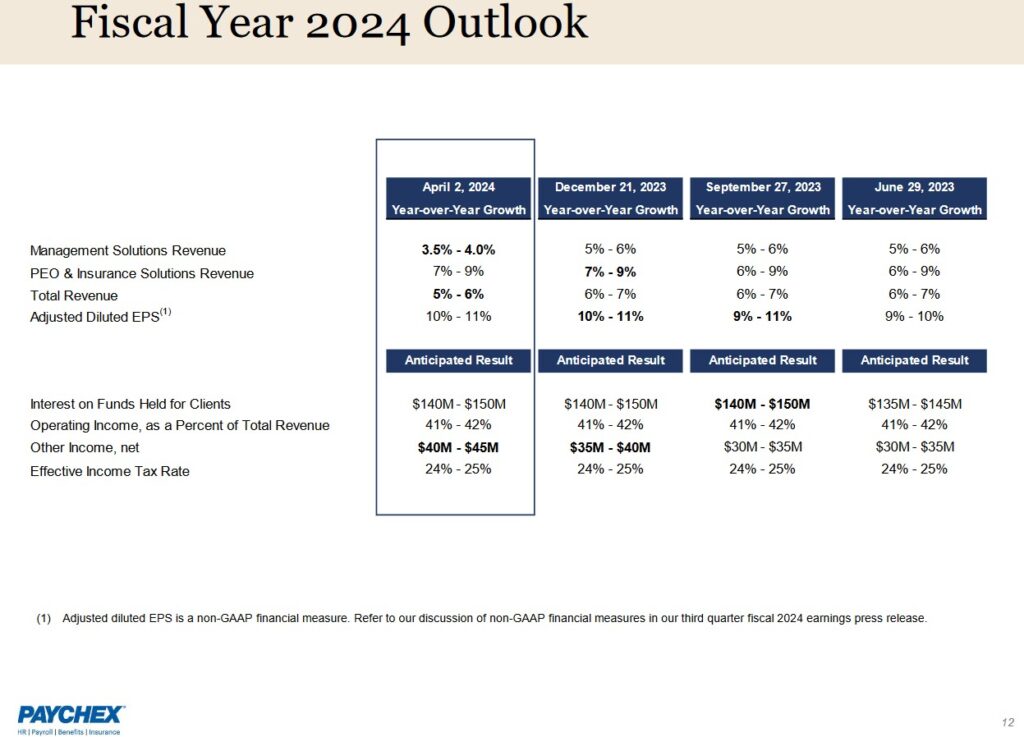
Source: PAYX - Q3 2024 Earnings Presentation - April 2, 2024
Preliminary thoughts regarding FY2025 is total revenue growth to be consistent with the Q4 growth rate.
Risk Assessment
No rating agency rates PAYX's debt but PAYX's risk is low.
It had current assets before funds held for clients of ~$3.807B of which ~$1.8B was cash, cash equivalents, and corporate investments and ~$1.681B was Accounts Receivable, net of allowance for credit losses and professional employer organization (PEO) unbilled receivables, net of advance collections.
At the end of Q3 2024, PAYX's Current Assets before funds held for clients were more than 2.16x Current Liabilities before client fund obligations.
Total short-term and long-term borrowings of ~$0.817B are similar to prior recent quarters.
On March 13, 2019, PAYX completed the private placement of Senior Notes, Series A in an aggregate principal amount of $0.4B due on March 13, 2026, and Senior Notes, Series B in an aggregate principal amount of $0.4B due on March 13, 2029.

Source: PAYX - Q1 2024 Form 10-Q
Unless PAYX makes another major acquisition for which debt financing will be required, I fully expect these Notes to be repaid thereby contributing to a further improvement in the quality of PAYX's financial picture.
Dividends and Dividend Yield
PAYX currently does not reflect its dividend history on its website; the dividend history is accessible here.
In 2020, PAYX froze its quarterly dividend at $0.62/share given the uncertainty the COVID pandemic would have on its business. Other than this brief period, PAYX has consistently rewarded its shareholders with attractive dividend increases (post 2013).
At the end of February, PAYX distributed its 4th consecutive $0.89/share quarterly dividend. I anticipate an $0.11/share increase to be declared in late April which would result in a $1.00/share quarterly dividend. If this happens, the next 4 quarterly dividend payments will total $4.00. Based on my April 2 ~$117.55 purchase price, the forward dividend yield would be ~3.4%.
Share repurchases is not a capital allocation priority. This is borne out from the relatively stable weighted average number of outstanding diluted shares (in millions rounded) of 363, 365, 366, 365, 363, 363, 362, 362, 361, 362, 363, and 362.3 in FY2012 - FY2023. The weighted-average diluted common shares outstanding in Q3 2024 was 361.7.
YTD, PAYX repurchased 1.5 million shares of its common stock at a weighted average price of $115.37/share for $169.2 million. There were no shares repurchased during the three months ended February 29, 2024.
PAYX maintained a program to repurchase up to $0.4B of common stock; this authorization expired on January 31, 2024 at which time $157.9 million of unused repurchase authorization expired.
On January 19, 2024, PAYX's Board approved a program to repurchase up to an additional $400.0 million of common stock, with authorization expiring on May 31, 2027. The purpose of this program is to manage common stock dilution.
Valuation
PAYX's FY2012 - FY2023 diluted PE levels are 20.19, 28.28, 26.08, 26.31, 28.32, 29.34, 23.44, 28.54, 31.80, 38.78, 28.53, 28.97, and 26.47.
At the time of my September 28, 2023 post, PAYX had generated $1.14 of adjusted diluted EPS in Q1 and management's FY2024 outlook was for 9% - 11% growth from FY2023's $4.27 adjusted diluted EPS. Using the 10% mid-point, PAYX's FY2024 adjusted diluted EPS was expected to be ~$4.70. Using the current ~$116.50 share price, PAYX's forward adjusted diluted PE was ~24.8.
In addition, the following were the forward-adjusted diluted PE levels using current broker estimates.
- FY2024 - 19 brokers - mean of $4.70 and low/high of $4.60 - $4.75. Using the mean estimate, the forward adjusted diluted PE was ~24.8.
- FY2025 - 18 brokers - mean of $5.01 and low/high of $4.91 - $5.15. Using the mean estimate, the forward adjusted diluted PE was ~23.3.
- FY2026 - 6 brokers - mean of $5.39 and low/high of $5.30 - $5.48. Using the mean estimate, the forward adjusted diluted PE was ~21.6.
When I wrote my December 21, 2023 post, management forecast 10% - 11% FY2024 adjusted diluted EPS growth. As noted above, PAYX generated $4.27 adjusted diluted EPS in FY2023. Using the 10.5% mid-point, I estimated PAYX's FY2024 adjusted diluted EPS would be ~$4.72. With shares currently trading just under ~$120, PAYX's forward adjusted diluted PE was ~25.4.
PAYX's valuation based on adjusted diluted earnings broker estimates and a ~$120 share price were:
- FY2024 - 19 brokers - mean of $4.70 and low/high of $4.64- $4.74. Using the mean estimate, the forward adjusted diluted PE is ~25.5.
- FY2025 - 19 brokers - mean of $5.02 and low/high of $4.93 - $5.15. Using the mean estimate, the forward adjusted diluted PE is ~24.
- FY2026 - 9 brokers - mean of $5.37 and low/high of $5.21 - $5.49. Using the mean estimate, the forward adjusted diluted PE is ~22.3.
PAYX's adjusted diluted EPS at the end of Q3 is $3.60, and therefore, it needs to generate $1.12 of adjusted earnings to reach $4.72 for the year; it generated $1.14, $1.08, and $1.38 in Q1, Q2, and Q3 so $1.12 does not seem to be a stretch.
On April2, I acquired shares at ~$117.55; PAYX's forward adjusted diluted PE using $4.72 is ~25.
PAYX's valuation based on adjusted diluted earnings broker estimates and a ~$117.55 share price are:
- FY2024 - 19 brokers - mean of $4.71 and low/high of $4.65- $4.74. Using the mean estimate, the forward adjusted diluted PE is ~25.
- FY2025 - 19 brokers - mean of $4.99 and low/high of $4.85 - $5.15. Using the mean estimate, the forward adjusted diluted PE is ~23.6.
- FY2026 - 12 brokers - mean of $5.30 and low/high of $5.20 - $5.47. Using the mean estimate, the forward adjusted diluted PE is ~22.
PAYX's Price/FCF in FY2014 - FY2023 is 19.04, 21.12, 21.83, 23.09, 18.78, 22.97, 25.75, 35.75, 25.63, and 21.75.
In the first 3 quarters of FY2024, it generated $1.322B of FCF. If it generates $0.44B of FCF in Q4, the FY2024 FCF should be ~$1.762B. Using a a weighted average of 362 million outstanding shares, the FCF/share should be ~$4.87. Based on my ~$117.55 purchase price, the forward P/FCF is ~24. This is reasonably consistent with prior year P/FCF results.
Final Thoughts
I have been a PAYX shareholder since July 2, 2009.
My exposure now consists of 829 shares (386 and 443 shares in a 'Core' and a 'Side' account, respectively).
When I completed my 2023 Year End FFJ Portfolio Review, it was not a top 30 holding; it is likely still not a top 30 holding.
As a relatively risk averse investor, I like that PAYX has the potential to become like some other holdings in the FFJ Portfolio where it has billions of cash, cash equivalents, and corporate investments and NO long-term debt.
I like that PAYX generates recurring revenue and switching service providers is disruptive. Furthermore, PAYX is not capital intensive company which enables it to consistently generating strong Operating Cash Flow (OCF) and Free Cash Flow (FCF). In FY20214 - FY2023, it generated FCF (in billions of $) of 0.797, 0.792, 0.921, 0.866, 1.122, 1.148, 1.314, 1.142, 1.372, and 1.556. In the first 6 and 9 months of FY2024, it generated 0.925 and 1.556.
It has taken roughly a decade for PAYX to double its Revenue, Operating Income, Net Income, Operating Cash Flow, and Free Cash Flow; there are many other companies that provide much more rapid growth. PAYX, however, consistently generates an Operating Margin in the upper 30s/low 40s. Furthermore, PAYX's results are not volatile.
PAYX's average annual total return (with dividend reinvestment) has been ~14.5% from April 1, 2014 to April 1, 2024. The average annual total return (with dividend reinvestment) over the past 5 years has been a bit more tepid at ~11.6%. If low-risk PAYX can generate a 10% average annual total return (with dividend reinvestment) going forward, I can expect to double my investment in just over 7 years. Naturally, past performance is not indicative of future performance.
I wish you much success on your journey to financial freedom!
Note: Please send any feedback, corrections, or questions to [email protected].
Disclosure: I am long PAYX.
Disclaimer: I do not know your circumstances and do not provide individualized advice or recommendations. I encourage you to make investment decisions by conducting your own research and due diligence. Consult your financial advisor about your specific situation.
I wrote this article myself and it expresses my own opinions. I do not receive compensation for it and have no business relationship with any company mentioned in this article.


